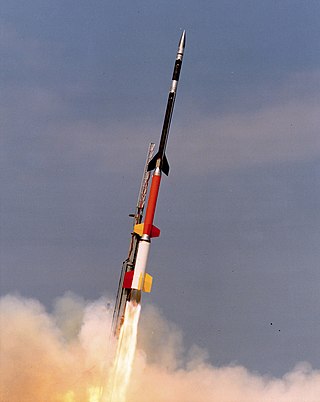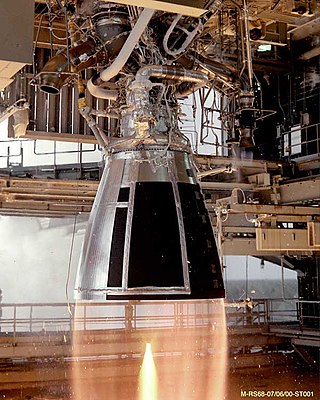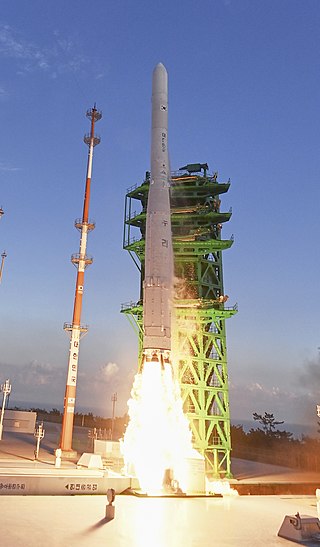
A rocket is a vehicle that uses jet propulsion to accelerate without using the surrounding air. A rocket engine produces thrust by reaction to exhaust expelled at high speed. Rocket engines work entirely from propellant carried within the vehicle; therefore a rocket can fly in the vacuum of space. Rockets work more efficiently in a vacuum and incur a loss of thrust due to the opposing pressure of the atmosphere.

A ramjet is a form of airbreathing jet engine that requires forward motion of the engine to provide air for combustion. Ramjets work most efficiently at supersonic speeds around Mach 3 and can operate up to Mach 6.

A hybrid-propellant rocket is a rocket with a rocket motor that uses rocket propellants in two different phases: one solid and the other either gas or liquid. The hybrid rocket concept can be traced back to the early 1930s.

Soyuz is a family of expendable Russian and Soviet carrier rockets developed by OKB-1 and manufactured by Progress Rocket Space Centre in Samara, Russia. With over 1,900 flights since its debut in 1966, the Soyuz is the rocket with the most launches in the history of spaceflight.

A sounding rocket or rocketsonde, sometimes called a research rocket or a suborbital rocket, is an instrument-carrying rocket designed to take measurements and perform scientific experiments during its sub-orbital flight. The rockets are used to launch instruments from 48 to 145 km above the surface of the Earth, the altitude generally between weather balloons and satellites; the maximum altitude for balloons is about 40 km and the minimum for satellites is approximately 121 km. Certain sounding rockets have an apogee between 1,000 and 1,500 km, such as the Black Brant X and XII, which is the maximum apogee of their class. Sounding rockets often use military surplus rocket motors. NASA routinely flies the Terrier Mk 70 boosted Improved Orion, lifting 270–450-kg (600–1,000-pound) payloads into the exoatmospheric region between 97 and 201 km.

A rocket engine uses stored rocket propellants as the reaction mass for forming a high-speed propulsive jet of fluid, usually high-temperature gas. Rocket engines are reaction engines, producing thrust by ejecting mass rearward, in accordance with Newton's third law. Most rocket engines use the combustion of reactive chemicals to supply the necessary energy, but non-combusting forms such as cold gas thrusters and nuclear thermal rockets also exist. Vehicles propelled by rocket engines are commonly used by ballistic missiles and rockets. Rocket vehicles carry their own oxidiser, unlike most combustion engines, so rocket engines can be used in a vacuum to propel spacecraft and ballistic missiles.
The Mohr Rocket was a sounding rocket developed by Ernst Mohr in Wuppertal, Germany.

Loki, officially designated 76mm HEAA Rocket T220, was an American unguided anti-aircraft rocket based on the German Taifun. Like the Taifun, Loki never saw service in its original role, but later found widespread use as a sounding rocket. It was so successful in this role that several advanced versions were developed on the basic Loki layout, including the final Super Loki.

Arcas was the designation of an American sounding rocket, developed by the Atlantic Research Corp., Alexandria, Va.

The Aggregat series was a set of ballistic missile designs developed in 1933–1945 by a research program of Nazi Germany's Armed Forces (Wehrmacht). Its greatest success was the A4, more commonly known as the V-2.

The Terrier Orion sounding rocket is a combination of the Terrier booster rocket with the Orion rocket used as a second stage. This spin stabilized configuration is most often used by the Goddard Space Flight Center, who operate out of the Wallops Flight Facility for sounding rocket operations. The system supports payloads ranging from 200 to 800 pounds, and is capable of achieving altitudes as high as 120 miles (200 km), but at least 50 miles (80 km), depending on payload size.

Vanguard TV-3BU, also called Vanguard Test Vehicle-Three Backup, was the second flight of the American Vanguard rocket. An unsuccessful attempt to place an unnamed satellite, Vanguard 1B, into orbit, the rocket was launched on 5 February 1958. It was launched from LC-18A at the Cape Canaveral Air Force Station. Fifty-seven seconds after launch, control of the vehicle was lost, and it failed to achieve orbit. At 57 seconds, the booster suddenly pitched down. The skinny second stage broke in half from aerodynamic stress, causing the Vanguard to tumble end-over-end before a range safety officer sent the destruct command. The cause of the failure was attributed to a spurious guidance signal that caused the first stage to perform unintended pitch maneuvers. Vanguard TV-3BU only reached an altitude of 6.1 km (3.8 mi), the goal was 3,840 km (2,390 mi).
HyShot is a research project of The University of Queensland, Australia Centre for Hypersonics, to demonstrate the possibility of supersonic combustion under flight conditions using two scramjet engines, one designed by The University of Queensland and one designed by QinetiQ.

Nuri, also known as KSLV-II, is a three-stage launch vehicle, the second one developed by South Korea and the successor to Naro-1 (KSLV-1). Nuri is developed by Korea Aerospace Research Institute (KARI). All three stages use indigenously developed launch vehicle engines, making Nuri the first indigenously developed South Korean orbital launch vehicle.
Exos Aerospace Systems & Technologies is an aerospace manufacturer and developer of reusable launch systems intended to support uncrewed orbital spaceflight launches, and is based in Caddo Mills, Texas.

Vanguard SLV-1, also called Vanguard Satellite Launch Vehicle-1 was hoped to be the second successful flight of the American Vanguard rocket following the successful launch of the Vanguard 1 satellite on rocket Vanguard TV-4 in March 1958.

Vanguard SLV-2, also called Vanguard Satellite Launch Vehicle-2 hoped to be the second successful flight of the American Vanguard rocket following successful Vanguard 1 satellite on rocket Vanguard TV-4.

Vanguard SLV-3, also called Vanguard Satellite Launch Vehicle-3 hoped to be the second successful flight of the American Vanguard rocket following successful Vanguard 1 satellite on rocket Vanguard TV-4.

Vanguard SLV-6, also called Vanguard Satellite Launch Vehicle-Six, hoped to be the third successful flight of the American Vanguard rocket following the successful Vanguard 2 satellite on rocket Vanguard SLV-4. Vanguard Satellite Launch Vehicle-6 (SLV-6) was designed to carry a small spherical satellite into Earth orbit to study solar heating of Earth and the heat balance. A faulty second stage pressure valve caused a mission failure.

LEX was a French experimental hybrid-propellant sounding rocket, developed by ONERA. It had the objective of testing a lithergol fueled rocket engine. It was the first rocket in history to use this technology, flying 8 times between 1964 and 1967.















